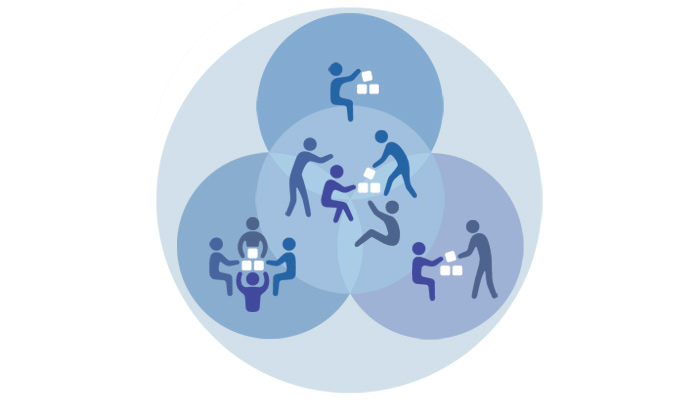Understanding Dynamic Working
Dynamism at the
workplace recognizes that different employees are talented and skilled
differently and that different people are optimally productive at different
times of the day. It focuses more on an employee’s output and less on the
number of hours worked. For as long as an employee plays his part in helping
the company achieve its vision, it really doesn’t matter the technology he used
or the time of the day he worked.
The concept of dynamic workplace has been actualized by technology.
Employees are now able to log on to a remote computer and work from home
just as effectively as they’d have done in the office. This allows
employees enough free time to attend to their personal business without
compromising their responsibilities at work.
But what are the
pros and cons of this new development?
3 Pros of a Dynamic Workplace
1. Increased employee retention
As a corporate leader, one of the primary objectives of Organisation should be to
create a workplace where each employee wants to come to every day and
never wants to leave. A dynamic workplace achieves this by relieving
employees off the pressure of meeting deadlines and goals. It focuses
more on facilitating employees set and meet their professional goals,
and in the process achieve the company goals. Employees celebrate
personal and professional milestones, they share happy moments together,
they bond, and they mingle with their seniors freely. The leadership
creates situations that cultivate togetherness and the feeling of family
among team members. As a result, team loyalty increases, productivity
levels rise, the employees feel happier, and employee retention
increases. In case that does not work either here’s some tips on how to deal with anxiety at work.
The company’s reputation as a dream workplace for most professionals in
the industry leads to the top talents wanting to join your company.
2. Better workplace relationships
Dynamism enhances communication and knowledge exchange at the
workplace. Not being tied down to a desk allows employees to have
serendipitous meetings with other colleagues and interact at a more
personal level. There is also a smoother flow of ideas between different
departments when employees interact freely. And in the case of
open-plan offices, employees find it easier to see each other and
exchange friendly gestures. All these lead to a happy and healthy
workforce. Research shows that good workplace relationships builds a
sense of loyalty amongst peers, colleagues are able to look after one
another, and everyone feels the commitment to perform well. Employees
are also able to find better work-life balance, which is vital for optimal productivity.
More over by investing in regular cleans or having a clean and neat
environment, this will only add up to their productivity. Additionally
this can also be attributed to the morning meetings that people have in
the office kitchen. Coffee, morning chatter, catch up with each other’s
business progress, is an integral part of building better workplace
relationships. In fact, it makes sense to have a comfortable space that
is available to everyone. And the good thing is that it is not that hard
to assemble one. Nowadays, there are Ready-to-Assemble kitchen cabinets that can be put in the kitchen within the day, so no fuss is created in the office.
3. Easier rotation
Job rotation in
low-sensitive positions curbs low productivity and stagnation. It challenges
employees to learn more and acquire new skills, which in turn prevents them
from coasting and boredom. It challenges employees to innovate and change
constantly.
As much as rotation
is important, many corporate leaders are unable to rotate employees who are
keen on protecting their status quo than on growing professionally. These
employees build networks during their time in 4-walled offices and use those
networks to create roadblocks against change.
This is not the
case in a dynamic office. When an employee interacts freely with colleagues
from other departments, he/she stops being skeptical about change. Such an
employee appreciates the need for cross-training; the need to learn new skills
for higher future potential. That makes your rotation task a little easier.
Cons of a Dynamic Workplace
1. Communication challenges
In a case where
employees work remotely and have to telecommute via their home computers,
organizing meetings becomes a bit tricky. Thanks to teleconferencing and
videoconferencing technologies, however, this challenge is gradually fading
away.
2. Noise
When employees move
freely in the office, noise distraction is almost inevitable. The good thing is
that you can install soundproofing materials in the office to absorb the noise.
You can, for example, install an acoustic board under your carpet to eliminate
the noise reflection effect of hard surface floors such as wood.
3. Depletion of individuality
From a worker’s
perspective, cross-training in a dynamic workplace makes you easily replaceable.
Anybody in the office can take your job. Besides, focusing too much on
collective success can easily deplete your individual ambitions.
“The growth and development of people is the highest calling of leadership.” – Harvey S. Firestone
Management often thinks that wage levels or benefits are the most
important elements of creating satisfaction in employees. But instead,
workers are saying, “Tell me how I’m doing” or “Help me grow and do a
better job.”
Of course they want feedback: It’s necessary to shape
their actions and behaviors in the workplace to align with desired
culture, established policy, and the leader’s expectations.
For the feedback process to be effective, these three elements must be clearly communicated.
1. Recognition of a specific action or behavior.
This recognition can be either in direct response to something we want
to see more of or less of in the future. We often say that “feedback is
best served warm,” meaning that it should happen as soon as possible
after observing the action or behavior, while it is still fresh and
relevant.
The feedback process is not appropriate for addressing
job performance, attitude, or other longer-term matters. These are
better dealt with through a performance review discussion or a coaching
session.
The conversation might begin with a description of the
action, such as “the way that you helped the team reach a consensus by
drawing each person in was great” or “the three crisp and concise
conclusions as you wrapped up your presentation really hit the mark.”
Or, in the case of corrective feedback, “the tone that you used in
replying to Joe seemed very condescending” or “the facts that you
presented don’t support the conclusions that you drew.”
Too
often people think that they are providing feedback with a very general
statement, such as “great job on the presentation” or “you add a lot to
this team.” Such general statements have little value for guiding
future behavior, thus not really constituting feedback. The more
specific and descriptive our statement, the better guidance it provides
for future behavior.
Often feedback is better received when we
first ask for permission, especially in the case of corrective feedback.
Also, when providing corrective feedback, a bit of positive at the
front end makes the recipient more open to the negative. An example
might be, “Your presentation was good, with a logical flow of the
background information and each slide was a nice, bite-sized addition to
our understanding, but may I offer some advice?” and then move into
identifying specific opportunities for improvement.
2. Identify the impact of the action or behavior. There
are two components of impact worth sharing: first, how the action or
behavior affected the person giving the feedback and second, the broader
impact, whether it be on the organization, audience, peers, etc.
Personalizing
the impact makes the feedback easier to digest. Did their action,
behavior, event, or process make you feel pleased, intrigued,
disappointed, angry, confused, excited, etc? If this is important enough
to provide feedback, there should be some emotion that arose, telling
you that you should address it. Perhaps this is a good time to remind
ourselves that, since feedback is important, we may need to train
ourselves to notice those opportunities and to respond and provide
feedback.
Providing a broader context aligns the person’s
performance with the organization’s values and goals. Did an action add
value to a meeting or discussion; did it fit nicely into the
organization’s desired culture; did it hinder a project or hurt a team’s
collaboration?
Again, our goal in feedback is to be as specific
as possible in order to tie the referenced action with the results,
either positive or negative. Specifics make it more likely for the
feedback to be clearly understood and accepted, thus increasing the
likelihood of long-term impact. A statement such as “You were rude, and I
don’t want that to happen again” has little value. Rather a statement
like this is more likely to gain the attention and acceptance of the
recipient: “I was disappointed to hear the rude comment you made when
you said ___. That sort of comment breaks down the cohesion of our team
and makes it more difficult to work together. We want this organization
to be a place where each person is valued and accepted.”
3. Set expectations for future actions or behaviors. Feedback
is about identifying what we want more, less, or the same amount of in
the future. This requires a statement or a discussion of our
expectations relative to the specific action that we are addressing. The
feedback process must provide clear expectations for the future. This
can be a simple statement, such as, “I hope you continue to find more
opportunities to repeat this” or “I trust you understand, agree, and
will not repeat this behavior.”
Depending upon the situation, the
third step of the feedback process might also include consequences or a
plan of action. If we are talking about a serious negative action or
behavior, the process may call for identifying the disciplinary action
that will take place in the event of a next occurrence. If we have
communicated the specific action and the specific impact of that action,
it is only natural that a specific consequence be communicated.
On
the other hand, the feedback discussion may be related to an action or
behavior that is beyond the recipient’s present capabilities. In this
case, the discussion may call for either the feedback recipient to
create a developmental plan of action or it may require that the
feedback provider and the recipient together define a developmental
plan.
One of the highest priorities for leaders is the development of the
people around them. Effective feedback is a tool to guide that
development. Spotting opportunities where feedback is appropriate and
then providing it in a way that helps the recipient’s development is the
best way to guide the growth of the people that we lead. Nudging the
actions and behaviors of team members to align with organizational
vision, goals, culture, and strategy is the best way to maximize the
effectiveness of the organization. As leaders, we need to understand the
power of feedback and prioritize the many opportunities for providing
it.
Implementing Integrated Work to Create a Dynamic Workplace


